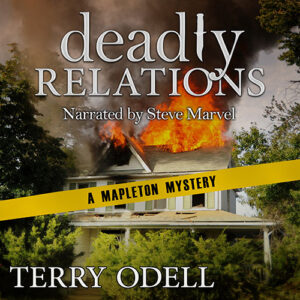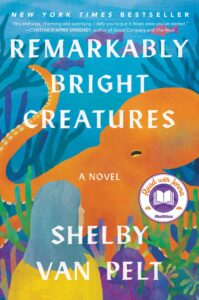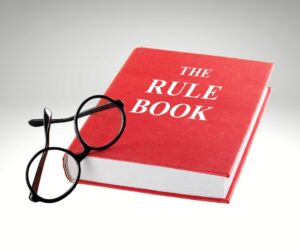An Interview with Narrator Steve Marvel
Terry Odell
 I’m pleased to have Steve “Captain” Marvel, the narrator of my Mapleton Mystery series, as my guest at The Kill Zone today. We’ve been working together for eight novels and a three-novella bundle and since I’m virtually clueless about how someone works with voice rather than fingers, I asked if he’d share a bit about himself and his process. He said he’d check in from time to time, so if you have any questions for him, ask away.
I’m pleased to have Steve “Captain” Marvel, the narrator of my Mapleton Mystery series, as my guest at The Kill Zone today. We’ve been working together for eight novels and a three-novella bundle and since I’m virtually clueless about how someone works with voice rather than fingers, I asked if he’d share a bit about himself and his process. He said he’d check in from time to time, so if you have any questions for him, ask away.
A little bit about your background qualifications as a narrator.
I studied Acting at a renowned university Theatre program and have had a four-decade stage career since. That time in the theatre has taught me how to create distinguishable characters, which lends itself very well to audiobook narration. Shortly after I started narrating, I won Audible’s Audiobook Narration contest. I’m only one of four narrators to have done so. I suppose you could say I’ve developed a skill in storytelling over the years which is serving me well in audiobooks.
How long have you been narrating audio books?
I started narrating audiobooks in 2013, although I had a regular job narrating a weekly financial newsletter for four years before that. So that’s about fourteen years, all told.
What other projects do you undertake?
For audiobooks, I go for titles that seem well-written by authors who like to collaborate. I tend to work mostly in detective fiction, thrillers, and sci-fi/fantasy, although I’ve done some fascinating non-fiction work, including a chronicle of the 1918 Spanish Flu pandemic, which is surprisingly popular, and a history of Star Trek, in which I voiced the words of William Shatner and Leonard Nimoy. That was a hoot.
Where other voiceover is concerned, I do a fair number of video games, mostly of the lighter-hearted, more tongue-in-cheek variety. I’ve voiced a lot of silly characters, including a series of fish and one fully non-verbal game in which I played five different monkeys. Those are fascinating challenges.
What made you decide to become a narrator?
Demand rarely exceeds supply within the acting business, but I discovered audiobook narration at a time when their popularity was exploding and publishers were actively seeking voices with acting ability behind them that could effectively portray characters and not just read copy. Audiobook narration also presents the actor with the opportunity to be not only the lead of the story, but every subordinate character, as well. He often functions as director, too, so the opportunity to exercise one’s creativity is greater than in just about any other area of the business.
 How do you decide what projects to pursue?
How do you decide what projects to pursue?
Besides the qualities I look for in both book and author that I mentioned earlier, economics play a role. I take projects that either pay an attractive rate (as a member of SAG-AFTRA, there’s an established minimum I’m allowed to accept), or which show prospects for royalty-share income adequate to compensate me for my time as a professional. Choosing the right book is part art and part science.
For audiobooks, how do you determine the voices for each character?
I look for clues within the book’s text. Obviously, gender and nationality (accent) factor prominently. Age and attitude can also come into play, as can physical characteristics—is the character described as rotund or slight, healthy or wan, etc.? The body affects how a person’s voice is produced fundamentally, so I use all clues to feel out the character’s spine, both literally and figuratively. I often adopt that physical posture as I voice the character, which changes the voice without my having to rely strictly on auditory memory.
How do you keep all the voices straight?
I typically concoct and record all the major character voices for a book after I’ve read it through and before I begin the narration. I keep a file of those audio clippings open on my computer as I record the narration and refer to it as needed to remind me of my choices for each.
How closely do you work with the author?
That tends to vary by author and publisher. For major publishers, one doesn’t always have access to the author (especially, as was the case in a narration last year, when the author had been dead for a decade!). With independent titles where author and publisher are typically one and the same, some authors are very “hands off” and only have something to say about the narration at the beginning and end of the project, and then usually about logistics. Other authors give feedback as chapters get recorded, generally about characters and specific line readings. I’ve been very fortunate to work only with authors who mostly give me creative freedom and intercede only when something really jumps out at them.
I always try to keep in close touch with the authors I work with and keep them in the loop as to my progress and any questions I might have.
What are your biggest challenges?
The sorrow of seeing worthy audiobooks go unnoticed. Many authors struggle to market their work effectively, and I feel for anyone who’s poured so much creativity into a project only to see it languish in the marketplace. Digital items can live a long time online, though, so hope springs eternal.
 What’s the favorite part of the job (not counting getting paid!)
What’s the favorite part of the job (not counting getting paid!)
Connecting with the characters and the story and performing an interpretation that comes out of my own creativity. Reading alone in the booth, in the dark, can have a decidedly meditative quality to it. As someone who enjoys spending his vacations on silent retreat, I find that aspect of the process very appealing.
What’s the least favorite part of the job?
Like many narrators, I find editing the audio tedious. I don’t mind voicing the edits, replacing a word or phrase here and there. What I do mind is the process of cutting out the “bad” sections to replace them with the “good.” I’m actually quite good at it, but it’s extremely time-consuming. I’d rather be narrating!
How long does it take you to record a “typical” novel?
My average audiobook runs about 10 hours in finished length. Figuring about four hours of recording/editing time per finished hour, a book takes about 40 hours of work to produce. It probably takes me another 10 hours to read the thing through initially and make notes.
As an author, I compose my manuscripts at the computer, using Word. I’m always moving things around, finding better words, and fixing mistakes. With a word processor, it’s a very simple task. I have copy, cut, and paste commands at my disposal. I can highlight a sentence or phrase and drag it somewhere else in the manuscript, or delete it altogether.
What do you do with the first narration of the manuscript before you return it to the author? Do you hire out to have someone clean up the sound quality? (And could you describe what kinds of things have to be cleaned?)
Because my recording environment is particularly quiet (I have my own “isolation” booth at home), I generally don’t have to do much to the audio before I send it off to the author. I edit out mistakes and misreads as I go along, using a technique known as “punch and roll” to erase the unwanted audio and replace it with the proper reading as I continue on with the narration. When I finish each chapter, I run the audio file through what we call an “effects chain”, which is just the software taking out any low-level hiss and normalizing all the volume levels in the file.
What about matching the narration to the manuscript? Do you have someone else take a pass through the manuscript to avoid as many missed bits as possible, or do you rely on the author for that step?
I tend to work with a proofer to check my audio after I’ve recorded it against the manuscript. That person specializes in proofing audio, so she picks up the vast majority of glitches and misreads. I’ve tried to do it myself, listening to each file after I’ve recorded it. I can say without qualification that I’m now happy to pay someone to do that for me.
Then, the bigger questions. If there’s a notation that you read a word/sentence wrong, what’s your process for fixing it? Can you drop in or replace a single word? Do you go back and re-read the sentence? The paragraph? Would you be willing to walk us through your process?
As I mentioned before, if I catch a mistake as I’m narrating, I immediately correct it and move on. For mistakes the proofer catches, it can be time-consuming to match newly-recorded audio to the old—distance between mouth and microphone and the condition of the voice can vary between recording sessions—so I prefer to re-record as little as possible to replace misreads or bad sound in a file. That means I typically re-read just the phrase containing the wrong word—that is, that part that falls between breaths, as those are natural pauses. So I tend to replace phrases and rarely whole paragraphs. Occasionally, I’ve re-recorded a single word, though mostly when the word stands alone for some reason. More common than replacing a single word is removing an extraneous one without having to re-record the whole phrase.
Also, rather than re-record a correction multiple times, I’ll sometimes “tweak” the correction I’ve read with a software tool—raising or lowering the volume or pitch slightly, for example. Over the years, I’ve developed a number of tricks I can use to reduce my editing time. One still has to listen to each edit itself, of course, to make sure it’s acceptable.
Audible doesn’t require a 100% match of audio with the ebook. Do you grumble when an author asks you to fix minor glitches, like “a” for “the”, etc.? Or do you discuss whether it’s worth changing with the author?
If the sense of the writing doesn’t change due to an omitted, added, or altered small word, I tend to leave it alone and try to prevail on the author to let it be. There is a cost, in time, to editing. Editing audio takes a surprisingly long time, due largely to the need to match old and new sound, as I mentioned previously. If I’ve requested the author to leave an “alternate read” as is and she pushes back, I go back and make the edit. Perhaps I’m lucky, but I’ve never yet worked with an author whose requests I’ve found to be unreasonable. Perhaps I’m also easy to get along with!
What about the less obvious parts of the narration? I know you and I talked about some of the characters and what they should sound like before you began the narration. But what if there’s a difference of opinion about things like inflection, or emphasis on a word when the author listens—things that aren’t obvious when you read a manuscript. Does it bother you to have to go back to fix those types of narration?
It’s funny—there’s a great deal of talk about “micromanaging” in the online narrator forums. Possibly due to luck, or possibly because I do so much preparation with the authors I work with beforehand, I’ve never had such a difference of opinion with an author that there were very many things to change. It’s rare that authors I work with request very much, so with what few requests for such changes I get, I’m usually happy to comply. You and I have had a discussion or two about pronunciations of certain words, which I believe we split about 50-50 to change or to not.
(An aside from Terry: An example from my work. “either” (and “neither”). I prefer “EEther, but Steve had recorded “EYEther” and I didn’t make him go back and change them.)
I think things also come down to a matter of confidence. I’ve narrated enough books to feel very confident in what I’m doing—and I’ve had a decades-long acting career to bolster the performance aspect—so I assume that confidence suffuses my dealings with the author. Having confidence tends to make one more accommodating, because he isn’t threatened by disagreement, and it also makes him sensitive to others’ wishes, because he’s not caught up in defending his own. Confidence tends to be contagious, so I suppose because of that, again, I just don’t encounter very many differences of opinion with the authors I work with.
Steve recently completed the narration of Deadly Relations, my newest Mapleton Mystery. You can listen to a sample on my website (upper left), and find buying options here.
For more about Steve, visit his website.
 Available Now in digital, paperback, and audio formats
Available Now in digital, paperback, and audio formats
Deadly Relations.
Nothing Ever Happens in Mapleton … Until it Does
Gordon Hepler, Mapleton, Colorado’s Police Chief, is called away from a quiet Sunday with his wife to an emergency situation at the home he’s planning to sell. A man has chained himself to the front porch, threatening to set off an explosive.
 Terry Odell is an award-winning author of Mystery and Romantic Suspense, although she prefers to think of them all as “Mysteries with Relationships.”
Terry Odell is an award-winning author of Mystery and Romantic Suspense, although she prefers to think of them all as “Mysteries with Relationships.”
 It’s summer. People are on vacation. Escaping the heat. Or trying to. As a diversion, I thought we might take a few minutes to have a little fun.
It’s summer. People are on vacation. Escaping the heat. Or trying to. As a diversion, I thought we might take a few minutes to have a little fun. Emails are a different game. I’m sure I’m not the only one who gets the occasional spam that sneaks past filters. Akismet, which I use on my website, is great. My business email account has very good filters, too.
Emails are a different game. I’m sure I’m not the only one who gets the occasional spam that sneaks past filters. Akismet, which I use on my website, is great. My business email account has very good filters, too. Available Now
Available Now Terry Odell is an award-winning author of Mystery and Romantic Suspense, although she prefers to think of them all as “Mysteries with Relationships.”
Terry Odell is an award-winning author of Mystery and Romantic Suspense, although she prefers to think of them all as “Mysteries with Relationships.”



















 Passive voice is something else again. Consider The dog bit the boy versus the boy was bitten by the dog. The former is active voice, the latter is passive voice. (I know someone out there is saying, “But what about The dog was bitten by the boy? That’s passive voice, but unexpected, and therefore more interesting.)
Passive voice is something else again. Consider The dog bit the boy versus the boy was bitten by the dog. The former is active voice, the latter is passive voice. (I know someone out there is saying, “But what about The dog was bitten by the boy? That’s passive voice, but unexpected, and therefore more interesting.)

 I’m pleased to have Steve “Captain” Marvel, the narrator of my Mapleton Mystery series, as my guest at The Kill Zone today. We’ve been working together for eight novels and a three-novella bundle and since I’m virtually clueless about how someone works with voice rather than fingers, I asked if he’d share a bit about himself and his process. He said he’d check in from time to time, so if you have any questions for him, ask away.
I’m pleased to have Steve “Captain” Marvel, the narrator of my Mapleton Mystery series, as my guest at The Kill Zone today. We’ve been working together for eight novels and a three-novella bundle and since I’m virtually clueless about how someone works with voice rather than fingers, I asked if he’d share a bit about himself and his process. He said he’d check in from time to time, so if you have any questions for him, ask away.
 What’s the favorite part of the job (not counting getting paid!)
What’s the favorite part of the job (not counting getting paid!)